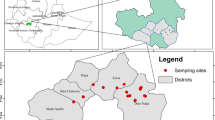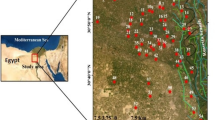Abstract
Cluster analysis (CA), discriminant analysis (DA), and principal component analysis/factor analysis (PCA/FA) were used to analyze the interannual, seasonal, and spatial variations of water quality from 1991 to 2011 in controlling points (Xinzhuang Bridge, Daguan Bridge) of the main rivers (Chaohe River, Baihe River) flowing into the Miyun Reservoir. The results demonstrated that total nitrogen (TN) and total phosphorus (TP) exceeded China National Standard II for surface water separately 5.08 times and 1 time. CA showed that the water quality could be divided into three interannual (IA) groups: IAI (1991–1995, 1998), IAII (1996–1997, 1999–2000, 2002–2006), and IAIII (2001, 2007–2011) and two seasonal clusters: dry season 1 (December), dry season 2 (January–February), and non-dry season (March–November). At interannual scale, the higher concentration of SO4 2− from industrial activities, atmospheric sedimentation, and fertilizer use in IAIII accelerated dissolution of carbonate, which increased Ca2+, Mg2+, total hardness (T-Hard), and total alkalinity (T-Alk). The decreasing trend of CODMn contributed to the establishment of sewage treatment plants and water and soil conservation in the Miyun upstream. The changing trend of NO3 −-N indicated increasing non-point pollution load of IAII and effective non-point pollution controlling of IAIII. Only one parameter T in the seasonal scale verified improved non-point pollution controlling. The major pollution in two controlling points was NO3 −-N, T-Hard, TN, and other ion pollution (SO4 2−, F−, Ca2+, Mg2+, T-Hard, T-Alk). Higher concentration of NO3 −-N in Xinzhuang and CODMn in Daguan indicated different controlling measures, especially controlling agriculture intensification in Chaohe River to decrease N pollution and decreasing water and soil loss and cage culture in Baihe River to weaken organic pollution. Controlling SO4 2− from industrial activity, atmospheric sedimentation and fertilizer use in watershed can effectively control Ca2+, Mg2+, T-Hard, and T-Alk.




Similar content being viewed by others
Abbreviations
- CA:
-
Cluster analysis
- DA:
-
Discriminant analysis
- IA:
-
Interannual
- PCA/FA:
-
Principal component analysis/factor analysis
- N and P:
-
Nitrogen and phosphorus
- VF:
-
Varifactor
References
Ajorlo, M., Abdullah, R. B., Yusoff, M. K., Halim, R. A., Hanif, A. H. M., Willms, W. D., & Ebrahimian, M. (2013). Multivariate statistical techniques for the assessment of seasonal variations in surface water quality of pasture ecosystems. Environmental monitoring and assessment, 185(10), 8649–8658.
Al-Taani, A. A. (2014). Trend analysis in water quality of Al-Wehda Dam, north of Jordan. Environmental monitoring and assessment, 186(10), 6223–6239.
Chang, H. (2008). Spatial analysis of water quality trends in the Han River basin, South Korea. Water Research, 42(13), 3285–3304.
Chen, Y., Ma, Q. Y., Wang, Y. T., Kang, F. F., Tian, P., & Lu, J. F. (2007). Water chemical properties of Miyun Reservoir, Beijing and the main rivers flowing into the reservoir. Journal of Beijing Forestry University, 29(3), 105–111.
Chuan, L. M., Zhao, T. K., An, Z. Z., Du, L. F., Li, S. J., & Ma, L. (2010). Research advancement in nitrate leaching and nitrogen use in soils. Chinese Agricultural Science Bulletin, 26(11), 200–205.
Cui, Y., Li, H. Y., Chen, W. M., & Zhou, W. P. (2014). Spatial and temporal distribution characteristics of water quality in Shahe Reservoir within Tianmuhu Reservoir and its relationship with phytoplankton community. Journal of Hydroecology, 35(3), 10–18.
Ge, X. L., Liu, X. R., Pan, X. C., Li, Q., & Luo, S. G. (2003). The geochemical characteristics of water body in Miyun Reservoir. Rock and Mineral Anakysis, 22(1), 44–48.
Geng, Z. H. (2001). Debris flow disaster and preventive measures in Miyun county. Beijing Water Resources, Beijing Water Resources, 6, 34–35.
Han, G. L., & Liu, C. Q. (2005). Hydrogeochemistry of rivers in Guizhou Province, China: constraints on crustal weathering in Karst Terrain. Advances in earth science, 20(4), 394–406.
Hong, C. S. (1995). Debris flow disaster and counter measure in Beijing. Beijing Water Resources, 4, 7–10.
Jassas, H., & Merkel, B. (2015). Assessment of hydrochemical evolution of groundwater and its suitability for drinking and irrigation purposes in Al-Khazir Gomal Basin, Northern Iraq. Environmental Earth Sciences, 74, 6647–6663.
Jiang, T. S., Yang, Z. S., Wang, M. Y., Huang, Z. F., Zhang, L., & Shi, J. J. (2012). The distribution characteristics and causes of fluoride in groundwater of southern district, Beijing. Journal of Arid Land Resources and Environment, 26(3), 109–111.
Kannel, P. R., Lee, S., Kanel, S. R., & Khan, S. P. (2007). Chemometric application in classification and assessment of monitoring locations of an urban river system. Analytica Chimica Acta, 582(2), 390–399.
Knutsson, G. (1994). Trends in the acidification of groundwater. IAHS Publications-Series of Proceedings and Reports-Intern Assoc Hydrological Sciences, 220, 107–120.
Lei, Y. Z. (1993). Wter chemistry of fresh water farming. Nanning: Guangxi sciencific and technical publishers.
Li, D. Q., Huang, D., Guo, C. F., & Guo, X. Y. (2015). Multivariate statistical analysis of temporal-spatial variations in water quality of a constructed wetland purification system in a typical park in Beijing, China. Enviromental Monitoring and Assessment, 187, 4219.
Li, T. T., Ji, H. B., Jiang, Y. B., & Wang, L. X. (2007). Hydro- geochemistry and the sources of DIC in the Upriver Tributaries of the Ganjiang River. Acta geographica sinica, 62(7), 764–775.
Li, Z. J., & Li, X. B. (2008). Impacts of precipitation changes and human activities on annual runoff of Chao River Basin during past 45 years. Scientia Geographica Sinica, 2008, 28(6), 809–813.
Li, W. Z., Li, X. Y., & Wang, X. X. (2013). Trends in the total nitrogen concentration and the major influencing factors in the main rivers flowing into the Miyun Reservoir in recent 20 years. Acta Scientiae Circumstantiae, 33(11), 3047–3052.
Li, Z. G., Wu, J. S., & Li, W. F. (2005). Danger evaluation of geological disaster in Miyun County. Rearch of Soil and Water Conservation, 12(4), 78–81.
Li, Y. L., Zhang, Y. H., Jia, H. F., & Chen, Q. H. (2014). Spatio-temporal characteristics and source identification of water pollutants in ancient town of Suzhou. Acta Scientiae Circumstantiae, 34(4), 1032–1044.
Liu, J. K. (1999). Advanced Hydrobiology (pp. 1–31). Beijing: Science publishers.
Liu, J. (2004). Studying on planktonand major eutrofication controlling factor of Miyun Reservoir [D]. Beijing: Doctoral dissertation, Capital Normal University.
Lu, Y. R., & Zhang, F. E. (2007). Research on development mechanism of sulphate-carbonate rocks’ compound karst and engineering impacts (pp. 135–142). Beijing: Higher education press.
Ma, H., Yang, D. W., Tan, S. K., Gao, B., & Hu, Q. F. (2010). Impact of climate variability and human activity on streamflow decrease in Miyun Reservoir catchment. Journal of Hydrology, 389, 317–324.
Muangthong, S., & Shrestha, S. (2015). Assessment of surface water quality using multivariate statistical techniques: case study of the Nampong River and Songkhram River, Thailand. Environmental Monitoring and Assessment, 187, 548.
Oketola, A. A., Adekolurejo, S. M., & Osibanjo, O. (2013). Water quality assessment of River Ogun using multivariate statistical techniques. Journal of Environmental Protection, 4, 466.
Pati, S., Dash, M. K., Mukherjee, C. K., Dash, B., & Pokhrel, S. (2014). Assessment of water quality using multivariate statistical techniques in the coastal region of Visakhapatnam, India. Environmental Monitoring and Assessment, 186, 6385–6402.
Pekey, H., Karakaş, D., & Bakoglu, M. (2004). Source apportionment of trace metals in surface waters of a polluted stream using multivariate statistical analyses. Marine Pollution Bulletin, 49(9), 809–818.
Shen, Z., Qiu, J., Hong, Q., & Chen, L. (2014). Simulation of spatial and temporal distributions of non-point source pollution load in the Three Gorges Reservoir Region. Science of the Total Environment, 493, 138–146.
Tanos, P., Kovács, J., Kovács, S., Anda, A., & Hatvani, I. G. (2015). Optimization of the monitoring network on the River Tisza (Central Europe, Hungary) using combined cluster and discriminant analysis, taking seasonality into account. Environmental Monitoring and Assessment., 187, 575.
Varol, M., Gökot, B., Bekleyen, A., & Şen, B. (2012). Spatial and temporal variations in surface water quality of the dam reservoirs in the Tigris River basin, Turkey. Catena, 92, 11–21.
Varol, M., & Şen, B. (2009). Assessment of surface water quality using multivariate statistical techniques: a case study of Behrimaz Stream, Turkey. Environmental monitoring and assessment, 159(1-4), 543–553.
Wang, X. Y., & Cai, X. G. (2002). Investigation of non-point pollution in watershed of Miyun Reservoir. Environmental Science and Technology, 25(4), 1–3.
Wang, X. Y., Guo, F., Cai, X. G., & Hu, Q. J. (2003). Non-point source pollution loading of Miyun Reservoir, Beijing. Urban environment & Urban ecology, 16(1), 31–33.
Wang, Y., Wang, P., Bai, Y., Tian, Z., Li, J., Shao, X., Mustavichc, Laura, F., & Li, B. L. (2013). Assessment of surface water quality via multivariate statistical techniques: a case study of the Songhua River Harbin region, China. Journal of Hydro-environment Research, 7(1), 30–40.
Wang, S., Wang, X., & Ouyang, Z. (2012). Effects of land use, climate, topography and soil properties on regional soil organic carbon and total nitrogen in the Upstream Watershed of Miyun Reservoir, North China. Journal of Environmental Sciences, 24(3), 387–395.
Wang, G., Xia, J., & Chen, J. (2009). Quantification of effects of climate variations and human activities on runoff by a monthly water balance model: a case study of the Chaobai River basin in northern China. Water Resources Research, 45, 7. doi:10.1029/2007WR006768.
Wu, X. F. (2009). Water quality in Miyun and Huairou Reservoir was under national standard II. China water industry.
Xing, X., & Ji, H. B. (2012). Hydro-chemistry characteristics and sulfur isotope variation of the water in the water source area of northern Beijing. Environmental chemistry, 31(6), 803–813.
Yang, D. Z., Xu, X. D., Liu, X. R., Ding, G. A., Xu, Q., Cheng, X. H., Chen, H. L., Zhou, H. G., Wang, Z. F., & Wang, W. Y. (2006). The compound related sources of atmosphere-soil-water pollution process in Miyun Reservoir. Science in China ser. D Earth Sciences, 35(A01), 195–205.
Yang, Y. H., Zhou, F., Guo, H. C., Sheng, H., Liu, H., Dao, X., & He, C. J. (2010). Analysis of spatial and temporal water pollution patterns in Lake Dianchi using multivariate statistical methods. Environmental monitoring and assessment, 170(1-4), 407–416.
Yu, Y. L., & Wang, Q. S. (2008). Analysis of seasonal changes of water quality in Miyun Reservoir and reaches of its main influents. Chinese Journal of Agrometeorology, 29(4), 432–435.
Zhang, W. W., Sun, D. F., Li, H., & Zhou, L. D. (2010). Surface water quality assessment in Miyun Reservoir watershed, Beijing in the period 1980-2003. Environmental science, 31(7), 1483–1491.
Acknowledgment
This work was supported by the National Natural Science Foundation of China (No. 40901281), the Beijing of Education Science and Technology Program (KM201310028012), and the International S&T Cooperation Program of China (2014DFA21620).
Author information
Authors and Affiliations
Corresponding author
Rights and permissions
About this article
Cite this article
Li, D., Liang, J., Di, Y. et al. The spatial-temporal variations of water quality in controlling points of the main rivers flowing into the Miyun Reservoir from 1991 to 2011. Environ Monit Assess 188, 42 (2016). https://doi.org/10.1007/s10661-015-5048-7
Received:
Accepted:
Published:
DOI: https://doi.org/10.1007/s10661-015-5048-7




